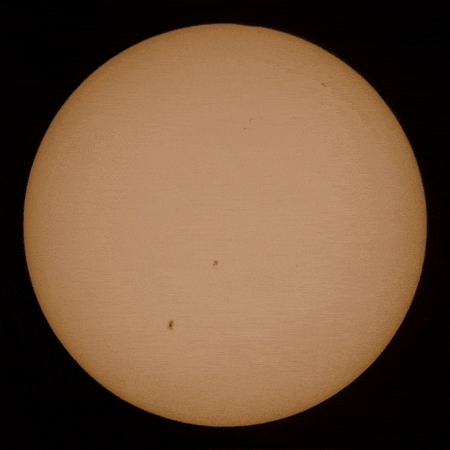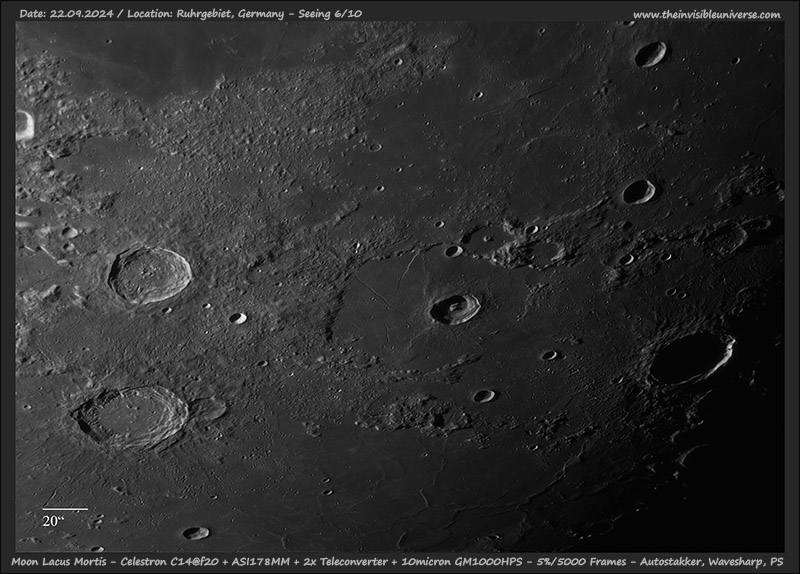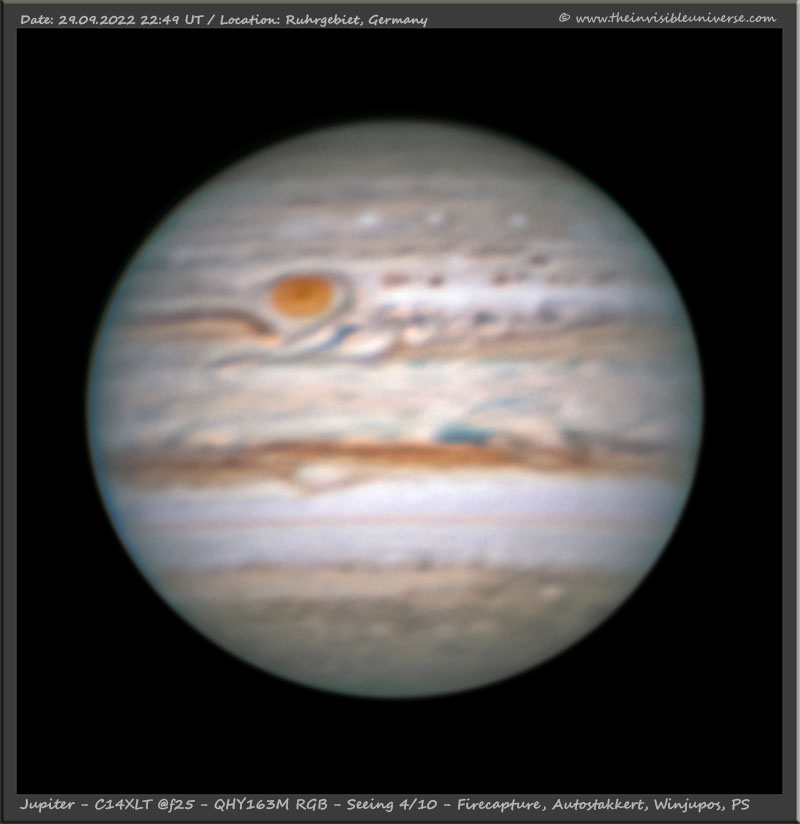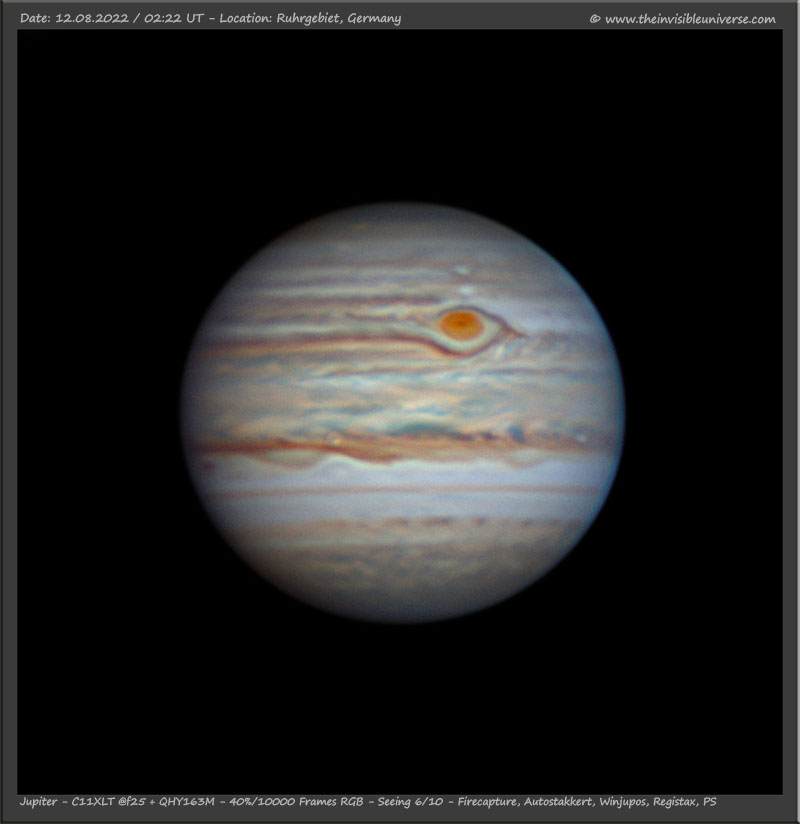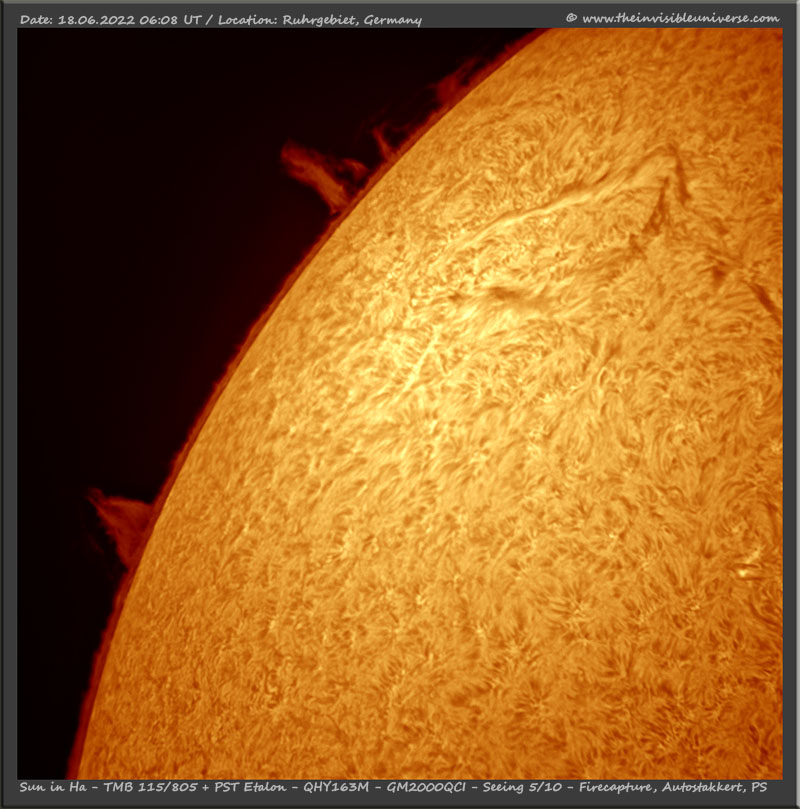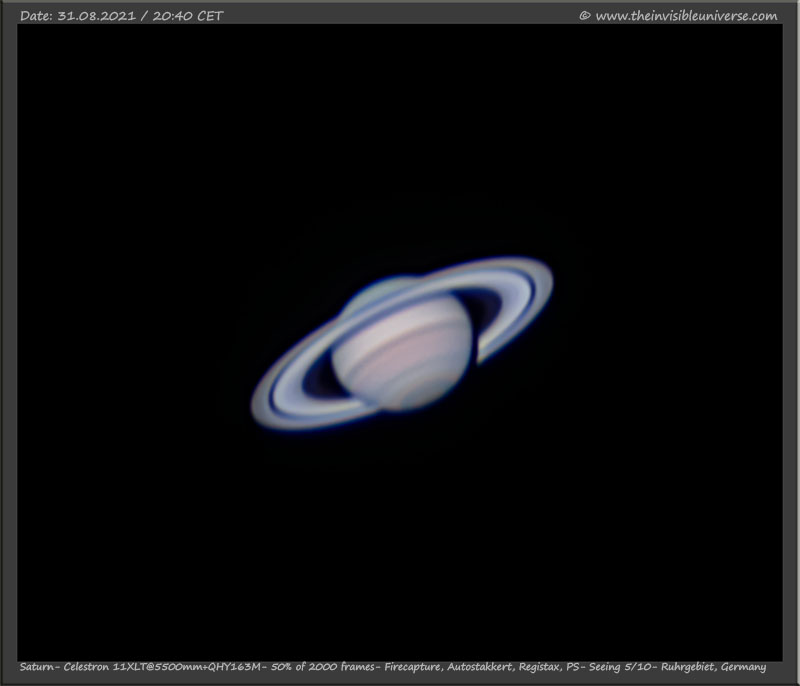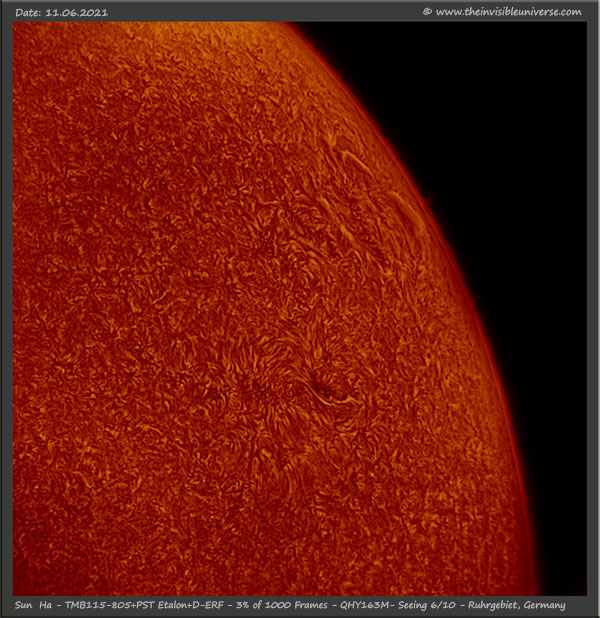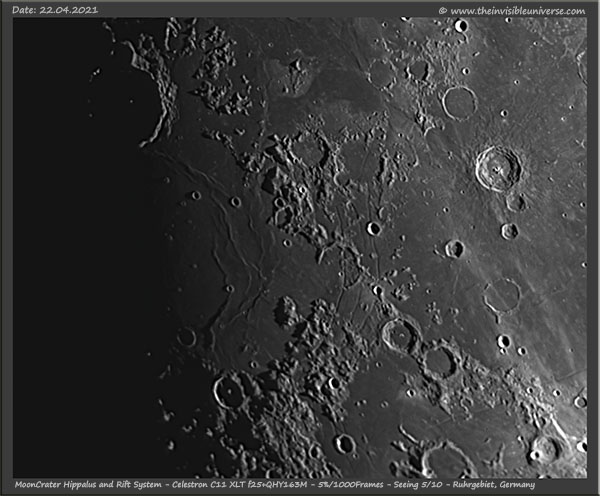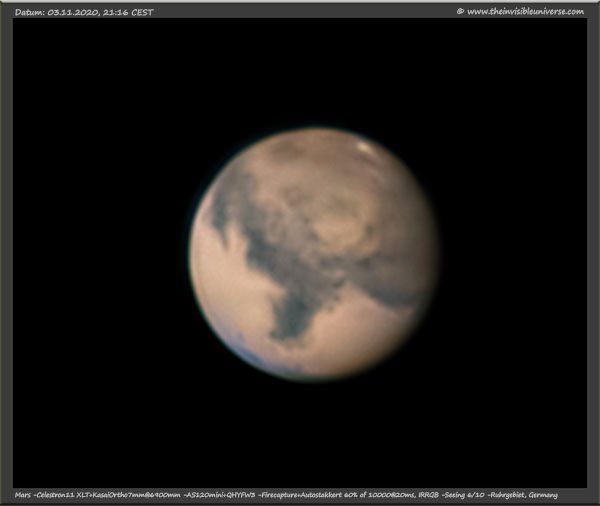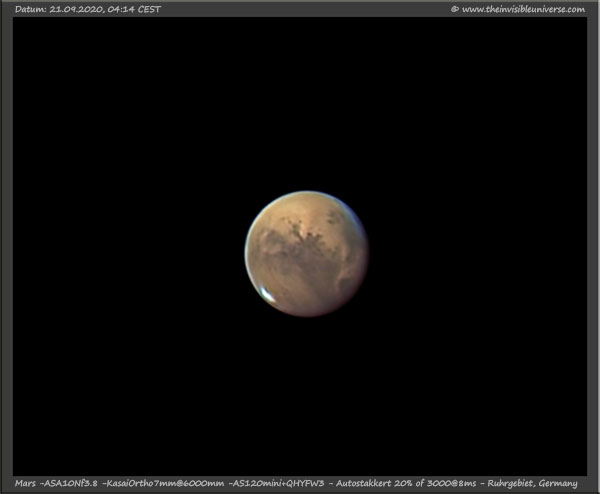- Top Links auf dieser Webpage:
Mein Youtube Kanal:
Solar System Picture Gallery
Most of the solar system images are recored in the Ruhrgebiet in Germany. The seeing is most of the time not very good (3-5/10 according to the pickering scale). For H alpha shots I use a TMB 115/805 APO with a 100 mm Baader C-ERF front filter and a PST Etalon combined with a 2" diagonal. For moon and planets I use the ASI120mini or the ASI178MM, both black and white USB3 cameras with small pixel. The optics currently in use is a Celestron C11 XLT Schmidt-Cassegrain and a Celestron C14 XLT.
For solar system photography, it always depends on the seeing conditions. I wish for a night with really excellent seeing conditions to take the solar system picture of a lifetime!
Link: Here is a summary of my Astroequipment.
Link: here is my Halpha imaging setup
A animation of the annular solar eclipse on October 14, 2023 taken near the town of Monticello, Utha, USA.
Canon EOS R with the EF-100-400 and a 2x teleconverter at 800mm focal length. Images aligned with the solar eclipse timelapse alignment tool.
A animation of Mars on November 09, 2020. I used 2 hours of data to generate an animation of the rotation with the morphing tool in PaintStar.
Celestron C11 XLT with eyepice projection using a Kasai 7mm Ortho@11000mm focal length. ASI120Mini@20ms, Gain 70. IRGB composite with 60% of 10000 frames each. 10 Micron GM2000 mount. Firecapture, Autostakkert, Registax 6 and Photoshop.
>
Link to the 4K video on my youtube channel.
During the long days in Covid-19 lockdown I explored the video editing possibilities in After Effects and created a short video of my recent panoramic moon pictures with labels of Mare, Craters and other prominent moon features. The panorama of the half moon was stiched with 6 separates tiles. Each tile was a sum of 5% of 1000 frames aquired with my QHY163M 4/3" CMOS camera and my Celestron C11 XLT at 2800mm focal length. The RGB full moon was aquired with my ASA 10N f3.6 astrograph and the same camera. I used RGB filters to created an enhanced color version of the moon. It is astonishing, how colorful the moon is, if colors are pushed in photoshop. Blue and red regions on the moon surface mark areas of different mineralogy.
Imaging equipment: Celestron C11 XLT@2800 focal length. QHY163M + Baader IR pass and RGB filter. 5% of 1000 frames. Seeing: 4/10. Mount: 10 Micron GM2000QCI mount. Software: Firecapture, Autostakkert, Luminar, Photoshop, After Effects and Premiere.
Probably my best Jupiter photo yet, taken on September 22, 2024, 03:12UT, at fairly good seeing.
Celestron C14 XLT with 2x Barlow at around f20 on a 10micron GM1000HPS mount. ASI178MM with Filterwheel and RGB Filters. 5% of 5000 frames per channel. Firecapture for capturing and Autostakkert for stacking. Winjupos for derotation. Wavesharp, Registax and PS for postprocessing.
Crater Posidonius at Mare Serenitatis on the Moon on September 22, 2024, at fairly good seeing.
Link: Annotated version of this picture.
Celestron C14 XLT with 2x Barlow at around f20 on a 10micron GM1000HPS mount. ASI178MM with Filterwheel and RGB Filters. 5% of 5000 frames. Firecapture for capturing and Autostakkert for stacking. Wavesharp, Registax and PS for postprocessing.
Lacus Mortis and crater Aristoteles and Eudoxus on September 22, 2024, at fairly good seeing.
Link: Annotated version of this picture.
Celestron C14 XLT with 2x Barlow at around f20 on a 10micron GM1000HPS mount. ASI178MM with Filterwheel and RGB Filters. 5% of 5000 frames. Firecapture for capturing and Autostakkert for stacking. Wavesharp, Registax and PS for postprocessing.
The Mare Nectaris, Montes Pyrenaeus and the craters Theophilius, Cyrillus and Catharina on the Moon on September 22, 2024, at fairly good seeing - at least for my observation location in the Ruhrgebiet with lots of heat sources and local seeing effects.
Since Autum 2022, I own a Celestron C14 XLT, an older 14-inch Schmidt-Cassegrain of ok quality that I happened to acquire at a bargain price. My 10micron GM1000HPS can hardly carry the 20+kg weight of this monster scope, but for planetary imaging and visual work it is ok. Annotation of the craters has been done with the aid of the program Virtual Moon Atlas.
Link: Annotated version of this picture.
Celestron C14 XLT with 2x Barlow at around f20 on a 10micron GM1000HPS mount. ASI178MM with Filterwheel and RGB Filters. 5% of 5000 frames. Firecapture for capturing and Autostakkert for stacking. Wavesharp, Registax and PS for postprocessing.
Jupiter on September 29, 2022, at 22:49 UT near its opposition. Since September 2022, I have owned a C14 XLT, an older 14-inch Schmidt-Cassegrain of good quality that I happened to acquire at a bargain price. My large 10micron mount is maxed out, but still supports the weight of the C14 plus a C11 converted to a Hyperstar system. Unfortunately, I have not yet been able to use the full power of this large telescope, as seeing conditions are quite poor this fall. What strikes me immediately is the better light gathering performance of the C14 compared to the C11. A shorter exposure time and lower gain help minimize blur and noise. In terms of volume and weight, the C14 dwarfs the C11, even though it's only 3 inches larger in diameter!
Celestron C14 XLT with 2x Barlow at around f20 on a 10micron GM2000 QCI mount. QHY163M with Filterwheel and RGB Filters. 10ms exposure time and Gain 220. 10000 frames per channel. Firecapture for capturing and Autostakkert for stacking. Derotation and RGB composition in Winjupos. Registax and PS.
Jupiter on August 11, 01:25 UT, and on August 12, 2022, at about 02:22 UT. A long stable period of good weather with hot temperatures around 35°C here in Germany provided quite stable seeing at night. So I was able to image Jupiter on several nights starting around 2 AM when the giant planet rose high enough above the trees at my observatory. The last years Jupiter was too low in the sky to take reasonable images, but since 2021 it is again high enough from my latitude to escape the turbulence near the horizon.
Celestron C11 XLT with 2x Barlow at around f25 on a 10micron GM2000 QCI mount. QHY163M with Filterwheel and RGB Filters. 20ms exposure time and Gain 220. 10000 frames per channel. Firecapture for capturing and Autostakkert for stacking. Derotation and RGB composition in Winjupos. Registax and PS.
Further Ha pictures of the sun from June 18, 2022.
TMB115-805 + PST Etalon and 110mm D-ERF Filter. QHY163M + Baader green filter. 3% of 1000 frames. 10 Micron GM2000 mount. Firecapture, Autostakkert and Photoshop.
The sun in Ha on April 24, 2022. The same sun spot group as on April 20.
TMB115-805 + PST Etalon and 110mm D-ERF Filter. QHY163M + Baader green filter. 3% of 1000 frames. 10 Micron GM2000 mount. Firecapture, Autostakkert and Photoshop.
The sun in Ha on April 20, 2022. The same sun spot group as one day before.
TMB115-805 + PST Etalon and 110mm D-ERF Filter. QHY163M + Baader green filter. 3% of 1000 frames. 10 Micron GM2000 mount. Firecapture, Autostakkert and Photoshop.
The sun in Ha on April 19, 2022. The same sun spot group as one day before. I have created a animation of the sun activity of this particular sun spot group over a period of 70 minutes. Each animation frame is the result of 10000 frames stacked in Autostakkert, sharpened in PS and animated AE and Premiere.
TMB115-805 + PST Etalon and 110mm D-ERF Filter. QHY163M + Baader green filter. 3% of 1000 frames. 10 Micron GM2000 mount. Firecapture, Autostakkert and Photoshop.
The sun in Ha on April 18, 2022. A huge group of sun spots is appearing on the edge of the sun, AR2993 and 2994.
TMB115-805 + PST Etalon and 110mm D-ERF Filter. QHY163M + Baader green filter. 3% of 1000 frames. 10 Micron GM2000 mount. Firecapture, Autostakkert and Photoshop.
The sun in Ha on March 28, 2022.
TMB115-805 + PST Etalon and 110mm D-ERF Filter. QHY163M + Baader green filter. 3% of 1000 frames. 10 Micron GM2000 mount. Firecapture, Autostakkert and Photoshop.
Jupiter in September and October 2021. Seeing was most of the time underaverage. This year I did not have the luck to have a period of good seeing compared to the year 2020 during the Mars opposition. High trees at the southern horizon in my garden with only a very small time window for observation and a period of bad weather contributed to the low yield of good pictures.
Celestron C11 XLT with eyepice projection using a Kasai 7mm Ortho or a 2x TS Barlow. QHY163M CMOS 4/3" Kamera with Optolong RGB filter. 10 Micron GM2000 mount. Firecapture, Autostakkert, Registax 6 and Photoshop.
Jupiter in the Planet season 2021. Images taken in August 2021. Unfortunately, Jupiter is still very low in the sky in the constellation of Capricornus and Aquarius. It reaches an altitude of not higher than 25° above the horizon at my observation location.
Celestron C11 XLT with eyepice projection using a Kasai 7mm Ortho or a 2x TS Barlow. QHY163M CMOS 4/3" Kamera with Optolong RGB filter. 10 Micron GM2000 mount. Firecapture, Autostakkert, Registax 6 and Photoshop.
Two images of Saturn in the Planet season 2021. Images taken in August 2021. Unfortunately, Saturn is still very low in the sky in the constellation of Capricornus. It reaches an altitude of not higher than 20° above the horizon at my observation location.
Celestron C11 XLT with eyepice projection using a Kasai 7mm Ortho. ASI120Mini@20ms. IRGB composite with 40% of 10000 frames each. 10 Micron GM2000 mount. Firecapture, Autostakkert, Registax 6 and Photoshop.
The sun in Ha on June 11, 2021. I experimented with an inverted grayscale to enhance the structures in Ha. The surface of the sun gets a more 3D like appearance.
TMB115-805 + PST Etalon and 110mm D-ERF Filter. QHY163M + Baader green filter. 3% of 1000 frames. 10 Micron GM2000 mount. Firecapture, Autostakkert and Photoshop.
The mineral moon in enhanced RGB colors on lunation day 10 in April 2021. On the right hand side I created an animated overlay of two RGB pictures of the moon taken on lunation day 7 and 10. Both images are taken with the ASA 10N f3.6 and the QHY163M in video mode. Stacking was done in Autostakkert, Color Enhancement in PS and the animation in Premiere. The perfect alignment of both moon pictures on different lunation days is difficult, as libration changes the visible moon surface and the stacking algorithm might change topographic alignment.
ASA 10N f3.6. QHY163M with Baader IR Pass Filter. Firecapture and Autostakkert with 5% of 1000 frames. Single Tiles with 16 Mpix. 10 Micron GM2000 mount. Firecapture, Autostakkert, Registax 6, Luminar and Photoshop.
This is a 6-tile panorama of the waxing moon on Lunation day 11 and 12. Two panoramic images with each 6 tiles were first stacked in Microsoft Image Compositor and afterwards blended in Photoshop with a mask. Stacking of lunar images on two different days enhance the visibility of craters which are not longer close to the terminator. To the right hand side a picture of my imaging setup for planetary photography with the C11 XLT and a QYH163M. The image was taken with the Canon EOS R and the IRIX Firefly 15mm f2.5.
Celestron C11 XLT@f10. QHY163M with Baader IR Pass Filter. Firecapture and Autostakkert with 5% of 1000 frames. 6 Tiles with each 12 Mpix merged in Microsoft ICE. 10 Micron GM2000 mount. Firecapture, Autostakkert, Registax 6, Luminar and Photoshop.
Crater Copernicus and Eratosthenes and the Montes Carpatus at the border of the Mare Imbrium and Mare Insularum on Lunation day 10 with 71% illumination.
Celestron C11 XLT@f10. QHY163M with Baader IR Pass Filter. 5% of 1000 frames. 10 Micron GM2000 mount. Firecapture, Autostakkert, Registax 6, Luminar and Photoshop.
On April 21 and 22, 2021 I took some long focal length shots of the waxing moon. During the previous observing session with my C11 XLT and a Baader Bino I spotted a weird crater that looked like it has a kind of inner ring structure inside the crater wall. On the high res picture I confirmed this observation. This crater is called Hesiodus A and only 15km or 8" in diameter. The bigger crater to the top is Hesiodus, the flooded crater to the right Pitatus. The picture to the right shows the Hippalus rift structure along crater Hippalus in Mare Humorum. Seeing on that day was unfortunately not good.
Celestron C11 XLT@f25. QHY163M with Baader IR Pass Filter. 5% of 1000 frames. 10 Micron GM2000 mount. Firecapture, Autostakkert, Registax 6, Luminar and Photoshop.
Another Ha image of the sun taken end of April 2021. This was the first larger sunspot I have seen for months.
TMB115-805 + PST Etalon and 110mm D-ERF Filter. QHY163M + Baader red filter. 5% of 1000 frames. 10 Micron GM2000 mount. Firecapture, Autostakkert, Luminar and Photoshop.
These are the first Ha sun images I have taken for a long time, as I had no suitable camera for Ha. This time I used the QHY163M with a TMB115-805 APO and the PST Etalon. It is very quiet on the sun nowadays as we just passed the solar minimum. Seeing was bad as well.
TMB115-805 + PST Etalon and 110mm D-ERF Filter. QHY163M + Baader red filter. 5% of 1000 frames. 10 Micron GM2000 mount. Firecapture, Autostakkert, Luminar and Photoshop.
Panorama of the Waxing Half Moon on February 20, 2021. This image was taken as a mosaic of 6 pictures with the QHY163M 4/3" camera on the Celestron C11XLT at 2800mm focal length. The original pictures has 90Mpx. The image was processed in Autostakkert, stacked in PS and sharpened in Luminar.
Full res picture with 90 Mpix: Link
Celestron C11 XLT@2800mm. QHY163M + Baader IR pass filter. 5% of 1000 frames, 6 Tiles. 10 Micron GM2000 mount. Firecapture, Autostakkert, Luminar and Photoshop.
Panorama of Moon on January 31, 2021.
Full res picture with 12 Mpix: Link
Celestron C11 XLT@2800mm. QHY163M + Baader IR pass filter. 3% of 1000 frames, 6 Tiles. 10 Micron GM2000 mount. Firecapture, Autostakkert, Registax 6 and Photoshop.
Panorama of the waxing moon on December 25, 2020. I used 8 tiles to make this mosaic. Unfortunately, at the end of the imaging session clouds obstructed the moon and I could not finish the work. I used the C11 with a f6,3 reducer and a Canon EF 2x III teleconverter, together with the QHY163M monochrome CMOS camera and a red filter. 0,2" per pixel image scale. The mosaic was created in Photoshop and exported in zoomify.
Celestron C11 XLT@4500mm. QHY163M and Baader red filter. 5% of 1000 frames each per tile, 8 tiles in total. 10 Micron GM2000 mount. Firecapture, Autostakkert, Registax 6 and Photoshop.
Moon on Nov. 24, 2020.
Celestron C11 XLT@4500mm. ASI120 Mini. Baader IR pass filter. 10% of 3000 frames. 10 Micron GM2000 mount. Firecapture, Autostakkert, Registax 6 and Photoshop.
Moon on Nov. 24, 2020.
Celestron C11 XLT@4500mm. ASI120 Mini. Baader IR pass filter. 10% of 3000 frames. 10 Micron GM2000 mount. Firecapture, Autostakkert, Registax 6 and Photoshop.
On Nov. 24, 2020 was a day with calm foggy weather. During the night the Moon was visible through a curtain of thin clouds. But the seeing was rather good, as the jet stream was deflected to the north by a high pressure area and the rest of the atmosphere was calm as well. I was able to produce some high resolution moon pictures with my ASI120 and the Celestron C11, better than most of the pictures I had acquired before. Especially Crater Copernicus was very impressing with all its details at the edge of the moon terminator.
Celestron C11 XLT@4500mm. ASI120 Mini. Baader IR pass filter. 10% of 3000 frames. 10 Micron GM2000 mount. Firecapture, Autostakkert, Registax 6 and Photoshop.
Mars on January 10, 2021. Three month after the opposition the Mars disc shrinked in its size well below 10". Bad weather, unstable seeing conditions and the shrinked disc of Mars made it much more difficult to take pictures of Mars in comparision to the opposition period back in October.
Celestron C11 XLT with eyepice projection using a Kasai 7mm Ortho. ASI120Mini@20ms. IRGB composite with 40% of 10000 frames each. 10 Micron GM2000 mount. Firecapture, Autostakkert, Registax 6 and Photoshop.
Mars on December 5, 2020. The disc size of Mars shrinked to aprox. 14". Bad weather, unstable seeing conditions and the shrinked disc of Mars made it much more difficult to take pictures of Mars in comparision to the opposition period back in October.
Celestron C11 XLT with eyepice projection using a Kasai 7mm Ortho. ASI120Mini@20ms. IRGB composite with 40% of 10000 frames each. 10 Micron GM2000 mount. Firecapture, Autostakkert, Registax 6 and Photoshop.
Mars on Nov. 23 and on Nov. 27, 2020. The disc size of Mars shrinked to aprox. 15". Furthermore, a dust storm has been reported by many observers. In these picture a weird greenish haze can be seen, maybe the dust storm. Furthermore, the resolution and detail visibility is greatly reduced.
Celestron C11 XLT with eyepice projection using a Kasai 7mm Ortho. ASI120Mini@20ms. IRGB composite with 40% of 10000 frames each. 10 Micron GM2000 mount. Firecapture, Autostakkert, Registax 6 and Photoshop.
Mars on Nov 11, 2020. The visibility of Mars deteriorates due to a shrinking disc size and unfavourable weather conditions in central Europe.
Celestron C11 XLT with eyepice projection using a Kasai 7mm Ortho@11000mm focal length. ASI120Mini@20ms, Gain 70. IRGB composite with 60% of 10000 frames each. 10 Micron GM2000 mount. Firecapture, Autostakkert, Registax 6 and Photoshop.
Even more Mars pictures from November 2020, roughly one month after opposition. The size of the Mars disc shriked to 18,5". Weather is playing games with me. I have to wait hours in my Observatory for short periods of clear skies. Catching 10000 frames per filter takes about 2-3 Minutes. However, seeing is ok. Unfortunately, the optical effects of the jet stream causes ring-like artifacts on the eastern side of the Mars disc.
Celestron C11 XLT with eyepice projection using a Kasai 7mm Ortho@11000mm focal length. ASI120Mini@20ms, Gain 70. IRGB composite with 60% of 10000 frames each. 10 Micron GM2000 mount. Firecapture, Autostakkert, Registax 6 and Photoshop.
Another Mars from November 3, 2020 between 19:34 and 20:16 UTC. The most prominent feature on this side of the Planet is Syrtis Major Planum, looking like the Indian subcontinent. It is flanked by Isidis Planitia on the left and Arabia Terra on the right. Near the center is Hellas Planitia. As opposition is over, Mars shrinks to 19" and shows a slight phase. Unfortunately, the opposition month October was dominated by unstable weather and bad seeing. Only in early November weather stabilized again, but still with mediocre seeing conditions. The Celestron C11 challenges me, as I have to collimate the optics after each pier flip on a star again at high magnification, to compensate for the inevitable mirror flop and to get the best optical performance out of the 11" aperture.
Celestron C11 XLT with eyepice projection using a Kasai 7mm Ortho@6900mm focal length. ASI120Mini@13ms. IR-RGB composite with 60% of 10000 stacked frames each. 10 Micron GM2000 mount. Firecapture, Autostakkert, Registax 6 and Photoshop..
More Mars pictures from the opposition in October 2020. I had to use short moments with clear skies during a long bad weather period. The new C11 however makes a good job. This time I aquired 10000 frames per channel each. Image quality is much better. Derotation however did not deliver a better sharper image. Please not the blueish fog at the pole and in some regions. I collected several dozend of Gigabyte of Mars videos in the last two month.
Celestron C11 XLT with eyepice projection using a Kasai 7mm Ortho@11000mm focal length. ASI120Mini@20ms, Gain 70. IRGB composite with 60% of 10000 frames each. 10 Micron GM2000 mount. Firecapture, Autostakkert, Registax 6 and Photoshop.
Mars on almost the same time, one day later than the previous picture, on October 14, 2020. Conditions were a little worse than the day before. The bright spot on the upper right is Olympus Mons. This high volcano is visible, because the blue filter catches the haze that surrounds the peak.
Celestron C11 XLT with eyepice projection using a Kasai 7mm Ortho@8700mm focal length. ASI120Mini@7ms, Gain 50. IR-RGB composite with 40% of 3000 frames each. 10 Micron GM2000 mount. Firecapture, Autostakkert, Registax 6 and Photoshop.
Another Mars picture from October 13, 2020. I had to fight with the bad weather conditions in late September and October, just during the opposition of the red planet. Mars reached a diamater of 22" during the 2020 opposition in October. Seeing was moderate. I had luck and could aquire a used Celestron C11 XLT in mint condition just in time for Mars opposition. In contrast to the ASA 10N, the C11 has a much smaller central obstruction and hence a better contrast for planetary imaging. Furthermore, the long native focal length of the optics is useful for having the optimum pixel scale of about 0,1"/px.
Celestron C11 XLT with eyepice projection using a Kasai 7mm Ortho@8700mm focal length. ASI120Mini@7ms, Gain 50. IR-RGB composite with 40% of 3700 frames each. 10 Micron GM2000 mount. Firecapture, Autostakkert, Registax 6 and Photoshop.
It is a long time ago since I posted a planetary image on my website. And I have never posted an image of Mars as I had none at all. So 2020 is the first time I had the opportunity to make an attempt to get a reasonable image of Mars. The red planet has a very good opposition sight in 2020 with about 22" diameter and a high altitude at my location. I used a newly aquired ASI120mmPro Mini and a QHY filter wheel with Optolong RGB filter to make an RGB composite. As seeing at my location is usually not very favourable for high resolution planetary imaging, the pictures have limited quality. Furthermore, the used ASA 10N Astrograph with 950mm focal length and a very large central obstruction of the secondary mirror is not the best weapon of choice for planetary imaging.
ASA 10N f3.8 with eyepice projection using a Kasai 7mm Ortho@6000mm focal length. ASI120Mini@6ms, Gain 50. RGB composite with 20% of 3000 frames each. 10 Micron GM2000 mount. Firecapture and Photoshop.
This is an images stack of the transit of the planet Mercury against the sun, shot on 09.05.2016 between 13:10 and 13:26 CEST. The small disc of the planet Mercury is slowly moving across the surface of the sun. The second picture from left was taken only seconds after the first contact and the 6th picture from left at the second contact.
I shot this image stack with my Canon 5DsR on a Canon EF 500 f4 L IS II USM super tele lens and a EF 2x III teleconverter at 1000mm focal length and f8. I used a Baader sun filter foil to reduce the solar energy and achieved 1/800s shutter speed at ISO200. The Sachtler DV6 on a Cartoni Smartstop tripod was used.
On 03.10.2011 I had an unusual good seeing at my location and fortunately I had time to make some videos of Jupiter with its moon Ganymed.
Celestron C9 with 2,5x Barlow at 5675 mm. DMK 31 with color filter wheel. 600 Frames stacked in Registax and Photoshop.
Planets. As the seeing from my location is most of the time very bad (3-4/10) I have not really many acceptable pictures of planets:
Webcam shots of the Moon. All the pictures are shot with a DMK31 USB camera in black and white, stacked and sharpened in Registax and Photoshop.


